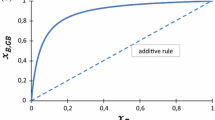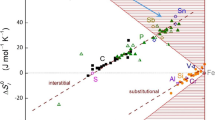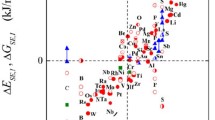Abstract
The theory of equilibrium solute segregation at solid/solid interfaces can be approached usefully from classical surface/gas adsorption isotherms of varying complexity and encompassing both chemisorption and physisorption behavior. Thus, the McLean segregation theory, the simplest type of behavior, is the counterpart of the Langmuir theory for solid/gas adsorption. Assuming strong pair interactions between segregate neighbors, the McLean theory can be adapted to a more complex form, the analogue of the Fowler isotherm, in which adsorbate clustering or protoprecipitation occurs. Again, multilayer segregation is possible, which can be rationalized by " BET " adsorption analogue behavior. Recent developments show how isotherms may be extended to multicomponent systems, assuming interactions between elements and segregants, with important implications in the behavior of embrittlement-prone engineering steels. The mass action equilibrium approach for surface adsorptive reactions is extended here to grain boundaries and tested on the limited number of isotherms available. This may prove to be a useful analytical procedure, giving a rapid insight into the nature of the segregation process, such as adsorbate interactions and variations in adsorption potential among the various sites.
Similar content being viewed by others
References
I. Langmuir:J. Amer. Chem. Soc, 1918, vol. 40, pp. 1361–68.
D. McLean:Grain Boundaries in Metals, 1957, Oxford University Press, pp. 118-19.
S. Brunauer, L. S. Deming, W. E. Deming, and E. Teller:J. Amer. Chem. Soc., 1940, vol. 62, pp. 1723–32.
M. P. Sean and E. D. Hondros:Proc. Roy. Soc. A, 1973, vol. 335, pp. 191–212.
R. H. Fowler and E. A. Guggenheim:Statistical Thermodynamics, pp. 429-33, Cambridge University Press, 1939.
M. P. Seah:Surf. Sci., 1975, vol. 53, pp. 168–212.
E. D. Hondros and M. P. Seah: “Segregation to Interfaces,”Int. Met. Rev., to be published, Metals Society, London.
M. Guttmann:Surface Sci., 1975, vol. 53, pp. 213–27.
D. Graham:J. Phys. Chem., 1953, vol. 57, pp. 665–69.
E. D. Hondros:Proc. Roy. Soc. A, 1965, vol. 286, pp. 479–98.
H. B. Aaron and G. F. Boiling:Grain Boundary Structure and Properties, by G. A. Chadwick and D. A. Smith, eds., pp. 107–38, Academic Press, London, 1976.
C. Pichard, M. Guttmann, J. Rieu, and C. Goux:J. de Phys., 1975, vol. 36, pp. C4–151 to 155.
J. L. Domange, J. Oudar, and J. Bénard:Molecular Processes on Solid Surfaces, E. Draugliset al, eds., pp. 353–64, McGraw Hill, New York, N.Y., 1969.
Author information
Authors and Affiliations
Additional information
This paper is based on a presentation made at a symposium on “Fundamentals of Grain Boundary Segregation” held at the Niagara Falls Meeting of The Metallurgical Society of AIME, September 21, 1976, under the sponsorship of the Physical Metallurgy Committee.
Rights and permissions
About this article
Cite this article
Hondros, E.D., Seah, M.P. The theory of grain boundary segregation in terms of surface adsorption analogues. Metall Trans A 8, 1363–1371 (1977). https://doi.org/10.1007/BF02642850
Issue Date:
DOI: https://doi.org/10.1007/BF02642850




